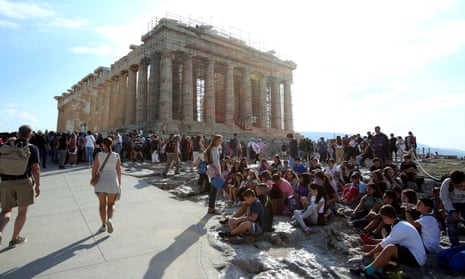Hordes of tourists huddle in groups along the cobbled boulevard beneath the Acropolis on a late November morning more summery than autumnal. Others get on and off the open-top doubledeckers running the riviera route. A man dressed as an ancient Marathon warrior poses “for a fee” with the majestic citadel in the background.
“We’re having a great year,” says the Greek tourism minister, Vassilis Kikilias. “It’s almost December and the season is still going which is exactly what we want – to extend it, bit by bit.”
Tourism in Athens – as Greece at large – has defied all expectation. The sector, the country’s economic engine, was budgeted to bring in €15bn this year and appeared doomed when bookings froze in February at the start of Russia’s invasion of Ukraine. Instead, earnings are more likely to exceed €18bn with visitor numbers poised to come close to 30 million – nearly three times the nation’s population – despite the war, absence of Chinese visitors and the unwanted appearance of jellyfish, says Kikilias.
At the height of the summer, about 16,000 holidaymakers each day were making the arduous climb up to the Acropolis. In the alleyways of Plaka, the neighbourhood beneath the ancient site, shopkeepers say they have never had it so good. “If anything, we just want them to go home now,” says Anna Simou, who works in a contemporary Greek design store in the district. “We’re all exhausted and that’s with management employing new staff.”

But the post-pandemic bounceback is not without risks. Kikilias is the first to say that the thriving industry needs to be spread more evenly beyond the “two and a half regions” drawing the crowds. Sustainability is also on the mind of Kostas Bakoyannis, the mayor of Athens, who last week called for a city tax to be placed on visitors to help cope with the surge in demand on services. In a departure from a time when the Greek capital was viewed invariably as a transit route to the islands, more than 7 million tourists are estimated to have descended on the metropolis in 2022.
“It’s unfair that 650,000 permanent residents in the heart of ancient Athens should foot the bill,” Bakoyannis says. “If we want to sustain the city we need to adapt in the way that almost every other European capital has, and introduce a city tax on visitors.”
Americans arriving on 63 direct flights a week have been key to making Greece the world’s third most popular tourist destination this year, according to industry figures. But as officials tally the success of a sector that accounts for 25% of GDP, the spectre of overtourism – long evident on islands such as Santorini – has spurred concerns over the dangers soaring numbers pose for the conservation of cultural gems.

As home to 18 Unesco world heritage sites, Greece is increasingly highlighting the challenges of managing visitor numbers, with experts emphasising the fine balance that needs to be struck between protecting ancient monuments and developing them for touristic use. The 495–429BC Acropolis, which is among the designated sites, was itself at the centre of controversy when in 2020 the government installed concrete pathways around the Periclean masterpiece and an unsightly glass and steel lift financed by private donors to improve access.
“Reds lights are flashing,” says Peter DeBrine, Unesco’s leading tourism adviser.“We have to start asking how much is too much and 16,000 visitors clogging a monument like the Acropolis every day sounds like way too much.”
DeBrine said studies had shown that, more than ever, travellers wanted sustainable options.
With tourism roaring back in both Europe and the US, it was imperative, he said, that capacity measures were adopted at popular heritage sites.
“We have gone from overtourism to revenge tourism with the same net effect,” he told the Guardian, describing the latter as a pent-up response to the pandemic. “What is needed is a radically different approach which starts with consumers but extends to tourism and heritage management. It’s clear that authorities have to take measures to relieve overcrowding at world heritage sites if the tourism experience isn’t to be degraded and conservation ensured.”
Unesco’s 50th anniversary convention in Delphi debated the impacts of the climate crisis and overtourism. It has urged members to change marketing tactics by focusing on attracting fewer, high-spending and lower-impact tourists, rather than large groups.
“Our hope is that tickets will soon only be sold online because that would be a sure way of limiting access,” says DeBrine, adding that adjustment of ticket prices according to season could also be enforced with entrance fees costing more at the height of summer. “Choosing to travel during the low or shoulder season makes a huge impact.”
Heritage sites in east Asia recently began implementing a new Unesco visitor management and strategy tool to identify a baseline for sustainable tourism.
“It’s given us a snapshot,” explained DeBrine. “We realise tourism is the lifeblood for so many communities and vital to local economies but overtourism is a real danger. Either you’re clever and you take measures or you kill the goose that lay the golden egg.”
